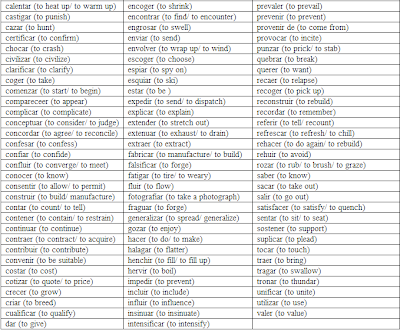Saturday, April 27, 2013
Wednesday, April 24, 2013
Preterit/Simple Past Tense
Source: StudySpanish.com
The preterite tense is used to refer to actions that occurred at a fixed point in time.
I called at 1:00. Llamé a la una.
The preterite tense is also used to refer to actions in the past that were performed a specific number of times.
I called you twice. Te llamé dos veces.
The preterite tense is also used to refer to actions that occurred during a specific enclosed period of time.
He lived there for 5 years. Él vivió allí por cinco años.
The preterite is also used for actions that are part of a chain of events.
I bought a hat, sat down on a bench and fell asleep. Compré un sombrero, me senté en un banco y me dormí.
The preterite is also used for sudden changes of mood, feelings or opinions.
At that moment, I was not afraid. En ese momento, no tuve miedo.
The preterite is frequently associated with phrases that pinpoint a particular occasion or specific time frame.
ayer-yesterday
ayer por la mañana-yesterday morning
ayer por la tarde-yesterday afternoon
anteayer-the day before yesterday
anoche-last night
desde el primer momento-from the first moment
después-afterwards
durante dos siglos-for two centuries
el año pasado-last year
el lunes por la noche-Monday night
el mes pasado-last month
el otro día-the other day
en ese momento-at that moment
entonces-then
esta mañana-this morning
esta tarde-this afternoon
hace dos días, años-two days, years ago
la semana pasada-last week
1- Verbs that end in AR: Video
Amar : love
Preterite:
yo amé
tú amaste
él/usted amó
nosotros amamos
ellos/ustedes amaron
2- Verbs that end in ER: Video
Comer : eat, feed
Preterite:
yo Comí
tú Comiste
él/usted Comió
nosotros Comimos
ellos/ustedes Comieron
3- Verbs that end in IR: Video
Vivir : be alive, live
Preterite:
yo viví
tú viviste
él/usted vivió
nosotros vivimos
ellos/ustedes vivieron
Thursday, April 18, 2013
Wednesday, April 10, 2013
Regular Verbs in Spanish/ Verbos Regulares en Español
Sources:
Regular Verbs: Part I
Spanish verb charts
List of Spanish Regular Verbs
Video 1: Present tense Part 1
Video 2: PRESENTE REGULAR (Present - regular verbs)
All Spanish verbs are either "regular" or "irregular." In this lesson we will look at three completely regular verbs:
hablar (to speak)
comer (to eat)
vivir (to live)
There are three categories of verbs:
-ar verbs (like hablar)
-er verbs (like comer)
-ir verbs (like vivir)
Wednesday, April 3, 2013
El uso del Hay/The use of There is and there are
Videos sobre el uso del Hay en ESPAÑOL e INGLES
"There is" y "There are" quieren decir "Hay" en español.
"There is" es singular y
"There are" es plural.
Ejemplos
There is a book. (Hay un libro.)
There are books. (Hay libros.)
Subscribe to:
Posts (Atom)






